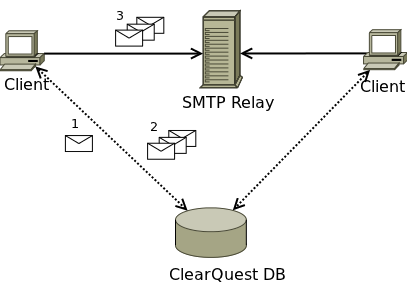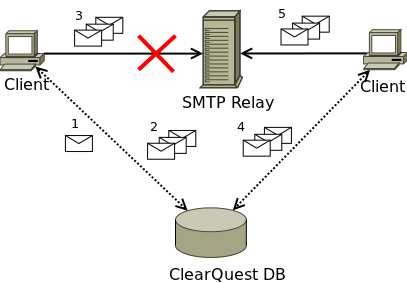Difference between revisions of "ClearQuest Email Notification Package Delivery Mode"
(Created page with "<big>'''Delivery Mode'''</big> Delivery Mode The package was designed to use Simple Mail Transfer Protocol (SMTP) for delivery of generated notification messages. SMTP allows t...") |
m |
||
| Line 11: | Line 11: | ||
== Deferred Delivery (default) == | == Deferred Delivery (default) == | ||
When no EN_Delivery mode property is set, or the property value is set to "Deferred," the package perform delivery in the following way. | When no EN_Delivery mode property is set, or the property value is set to "Deferred," the package perform delivery in the following way. | ||
| − | [[File:Deferred_Delivery_1.png]] | + | |
| + | [[File:Deferred_Delivery_1.png | center]] | ||
When user is executing some action in ClearQuest, email rules are evaluated. All email messages created in result are stored in the ClearQuest database (1). A special stateless record type, en_email_message, a part of the package, is used to keep these messages. When rules evaluation is completed, the same ClearQuest client queries the database for all email messages that are eligible for delivery (2), and deliver them to the SMTP server (3). When message transfer is successful, these messages are accepted for further delivery to the recipients by the server. | When user is executing some action in ClearQuest, email rules are evaluated. All email messages created in result are stored in the ClearQuest database (1). A special stateless record type, en_email_message, a part of the package, is used to keep these messages. When rules evaluation is completed, the same ClearQuest client queries the database for all email messages that are eligible for delivery (2), and deliver them to the SMTP server (3). When message transfer is successful, these messages are accepted for further delivery to the recipients by the server. | ||
It might be possible that SMTP server was not able to accept emails for delivery. For example, it could be down for maintenance, overloaded; connection could be blocked by firewall or internet security software installed on the user's machine. | It might be possible that SMTP server was not able to accept emails for delivery. For example, it could be down for maintenance, overloaded; connection could be blocked by firewall or internet security software installed on the user's machine. | ||
| − | [[File:Deferred_Delivery_2.png]] | + | |
| + | [[File:Deferred_Delivery_2.png | center ]] | ||
In this case, these messages would be queried when action is performed by other ClearQuest client, at the end of its own rules evaluation cycle (4) to be delivered (5). | In this case, these messages would be queried when action is performed by other ClearQuest client, at the end of its own rules evaluation cycle (4) to be delivered (5). | ||
| Line 24: | Line 26: | ||
== Light Delivery == | == Light Delivery == | ||
| + | When notification audit trail is not so important, and you would like to minimize interactions with database without sacrificing reliability, you can consider using '''Light''' delivery mode. | ||
| + | |||
| + | [[File:Light_Delivery.jpg | center]] | ||
| + | |||
| + | In this case, generated email messages delivered immediately to the SMTP server (1), and only when the server is unavailable or delivery is blocked, the message will be dumped to the database to be queried (2) and delivered (3) by the same or other client later. | ||
== Queue Delivery == | == Queue Delivery == | ||
Revision as of 19:31, 19 August 2011
Delivery Mode
Delivery Mode
The package was designed to use Simple Mail Transfer Protocol (SMTP) for delivery of generated notification messages. SMTP allows to unify configuration for all possible ClearQuest clients (Windows, Eclipse, UNIX, CCWeb), but requires a mail server, also called SMTP relay, to accept incoming messages either anonymously, or using some credentials for authentication. Usually, it is not a problem. Many tools employ SMTP, and your would not be first who approached system administrators asking for mail server configuration information in your organization. They should be able to assist you.
It does not mean that SMTP is the only mechanism that can be employed. SMTP is "out of the box" solution, but other protocols can be plugged in.
There are three main delivery modes supported by the package: Deferred (default), Light, and Queue. Delivery mode is controlled by EN_DeliveryMode database property.
Contents
Deferred Delivery (default)
When no EN_Delivery mode property is set, or the property value is set to "Deferred," the package perform delivery in the following way.
When user is executing some action in ClearQuest, email rules are evaluated. All email messages created in result are stored in the ClearQuest database (1). A special stateless record type, en_email_message, a part of the package, is used to keep these messages. When rules evaluation is completed, the same ClearQuest client queries the database for all email messages that are eligible for delivery (2), and deliver them to the SMTP server (3). When message transfer is successful, these messages are accepted for further delivery to the recipients by the server.
It might be possible that SMTP server was not able to accept emails for delivery. For example, it could be down for maintenance, overloaded; connection could be blocked by firewall or internet security software installed on the user's machine.
In this case, these messages would be queried when action is performed by other ClearQuest client, at the end of its own rules evaluation cycle (4) to be delivered (5).
Maximum number of delivery attempts is 5, and can be changed by setting EN_DeliveryAttempt property. When maximum number of delivery attempts is reached, further delivery can be performed by ClearQuest administrator by executing Send Message action on the en_email_message records, or by resetting number of delivery attempts on them.
Light Delivery
When notification audit trail is not so important, and you would like to minimize interactions with database without sacrificing reliability, you can consider using Light delivery mode.
In this case, generated email messages delivered immediately to the SMTP server (1), and only when the server is unavailable or delivery is blocked, the message will be dumped to the database to be queried (2) and delivered (3) by the same or other client later.

